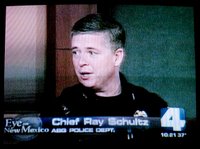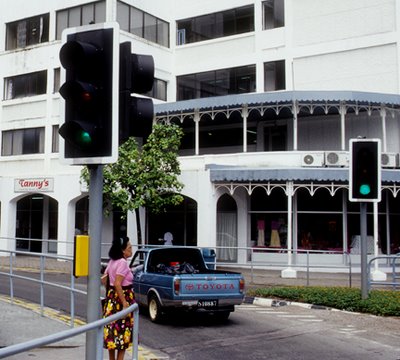 This is a still image taken off my TV screen of KOB-TV’s Sunday morning talk show, “Eye on New Mexico,” Dennis Domrzalski and Nicole Brady hosting Albuquerque Police Chief Ray Schultz and lawyer Paul Livingston on Dec. 10 as they discussed red light and radar cameras at 11 city intersections.
This is a still image taken off my TV screen of KOB-TV’s Sunday morning talk show, “Eye on New Mexico,” Dennis Domrzalski and Nicole Brady hosting Albuquerque Police Chief Ray Schultz and lawyer Paul Livingston on Dec. 10 as they discussed red light and radar cameras at 11 city intersections. Schultz indicated that he hoped that drivers’ behavior would change so much that it would bankrupt the cameras and that they would no longer pay for themselves.
Schultz indicated that he hoped that drivers’ behavior would change so much that it would bankrupt the cameras and that they would no longer pay for themselves.Has anybody bothered to look at the theory of traffic control? It has a few concepts that seem overlooked and definitely not capitalized upon when it comes to red light cameras.
The first concept is that traffic control is meant to keep all users of roadways safe. Therefore, no one may enter an intersection when someone is already in the intersection or about to enter, whether legally or not.
When we look at the data of accidents caused by vehicles running red lights, we find that it is not the vehicle that is a fraction of a second late. It is the vehicle that is really late that poses the real danger. When cross traffic, passing through the intersection, at the posted speed limit strikes or is struck by the vehicle running the red light, is where such accidents cause the dangers that the cameras are suppose to eliminate.
I believe that the majority of vehicles caught entering the intersection after the change of the traffic control signal light from yellow to red is recorded within a fraction of a second.
So what’s wrong with this picture?
 Consider a couple of seconds.
Consider a couple of seconds.In sitting through several sessions of the city administrative hearing officer’s red light hearings, one of the most common themes repeatedly heard is the complaint of the short period of time that the cautionary yellow light is illuminated. Three to three and a half seconds at 30 to 35 mph, seems an inadequate amount of time for drivers to stop.
One second: add just one-second of time to the yellow light.
Two seconds: Change the red to green cycle to hesitate just one-second and do not turn on the camera until the cross traffic signal changes to green.
I predict bankruptcy in… about… wait for it; two seconds!
For those who think adding two seconds to the entire cycle will extend their traffic commute; don’t add the time, subtract it from the green time and give it to the yellow.
If it is the actual intent of the mayor, chief and traffic control division to reduce the number of serious accidents at intersections, instead of just generating revenue as they bypass the judicial process for traffic offenses, then adopting two additional seconds certainly can’t hurt.
In my travels around the country and in other parts of the world, I have observed this and other traffic light sequencing schemes; including turning on the yellow light while the green is still lit before going solid yellow and the adding red to the yellow for a couple of seconds before going solid red.
 You’ve heard of the one-stoplight town; here is a one-stoplight country. This is the only stoplight in Victoria, on the island of Mahe, the capital of the Seychelles Islands, in the Indian Ocean. At this stoplight, a yellow light is shown prior to the end of the red, just like a yellow light is shown prior to the end of the green.
You’ve heard of the one-stoplight town; here is a one-stoplight country. This is the only stoplight in Victoria, on the island of Mahe, the capital of the Seychelles Islands, in the Indian Ocean. At this stoplight, a yellow light is shown prior to the end of the red, just like a yellow light is shown prior to the end of the green. It just goes to show you, that there are other ideas out there and they work.
No comments:
Post a Comment